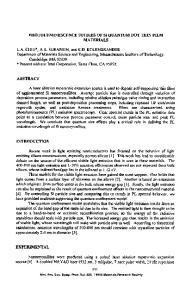Experimental Studies of Photoluminescence in Mn-Ion Implanted Silicon Rich Oxide Thin Film
- PDF / 80,360 Bytes
- 5 Pages / 612 x 792 pts (letter) Page_size
- 85 Downloads / 292 Views
0910-A08-08
Experimental Studies of Photoluminescence in Mn-Ion Implanted Silicon Rich Oxide Thin Film Wei Pan1, R.G. Dunn1, M.S. Carroll1, and Y.Q. Wang2 1 Sandia National Laboratories, Albuquerque, New Mexico, 87185 2 Materials Science and Technology Division, Los Alamos National Laboratory, Los Alamos, New Mexico, 87545
ABSTRACT In this paper, we wish to report our preliminary experimental results from the photoluminescence (PL) studies in a Mn-ion implanted silicon-rich oxide (SRO) thin film. At 4 K, a broad PL peak, centered at ~ 1.2 eV, was observed. It is blue-shifted from the Si substrate peak at ~ 1.1 eV. The temperature (T) dependence of PL was carried out at zero magnetic (B) field and B = 0.5 Tesla, respectively, and showed quantitatively different behaviors. At B = 0, the PL intensity increases very slowly at low temperatures and reaches a maximal value at ~ 40 K. It then decreases as T is further increased. At B = 0.5 Tesla, the peak temperature (Tpeak), whether the intensity is maximal, moves to ~ 80-100 K, and the decreasing rate beyond Tpeak is much smaller than that at B = 0. We speculate that these two different behaviors might reveal, possibly, a ferromagnetic ordering in Mn-ion doped silicon nanocrystals. INTRODUCTION It has become clear that the conventional silicon transistor technology is approaching its limitations. New device physics is needed for next generation information process and storage. In recent years, it has witnessed the advent of magnetoelectronics and spintronics, in which one can combine magnetism and solid state electronics via spin-dependent transport process [1,2]. The conventional electronics devices move electronic charge around. In these novel spintronic devices, both charge and spin degree freedoms can be manipulated. Spintronic devices have the potential to operate at considerably higher speeds and consume less power. Of course, before the spintronc device can take off as a viable industry, we have to answer the following questions: Can we combine ferromagnetic metals and semiconductors in integrated circuits? If yes, can we make magnetic semiconductor devices that work at room temperature? Among the many approaches of combining magnetic ions and semiconductors, the dilute magnetic semiconductor of epitaxially grown III-V semiconductor, Ga1-xMnxAs, has attracted the most attention. A Curie temperature of as high as 150 K has been achieved in this material system [3]. However, for real applications, any device has to be able to function at room temperature. A critical hurdle to producing an operating room temperature spintronic device is to maintain the spin polarization and coherence. Recently, an above room temperature ferromagnetism in Mn-ion implanted silicon (Si) has been demonstrated [4]. This result is very stimulating because it suggests that a critical component for spin based field effect transistors (FET) may be achievable in silicon, making it better suited for spin dependent transport process.
Here, we wish to report preliminary experimental results in
Data Loading...



